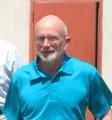
On March 28th, 2012, a beautiful Spring day, staff from the EarthScope/EPIC, Incorporated Research Institutions for Seismology (EarthScope), US Geological Survey, Sandia National Labs, and students assembled for the surprise dedication of the EarthScope/EPIC seismometer testing vault to Jim Fowler, founding Program Manager for EarthScope/EPIC (see "EarthScope/EPIC Celebrates Career of Jim Fowler", March 9th, 2012).
Before a large gathering of more than 75 people, Bob Woodward, EarthScope Director for Instrumentation Services emceed a series of speakers that included Rick Aster of NMT/EES and David Simpson, President of EarthScope. David Simpson presented Jim's wife, Cynthia, with a bouquet of flowers in recognition for her contribution during Jim's 25 years of service. Jim was then invited to the podium, where he thanked the staff of EarthScope/EPIC and EarthScope for "the easiest job he has ever had."











